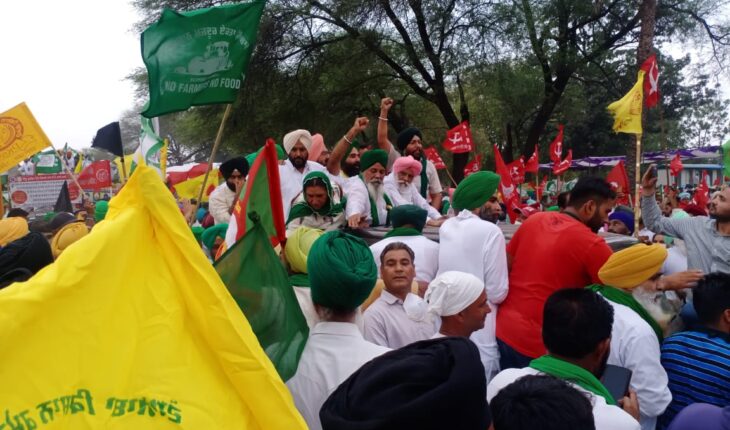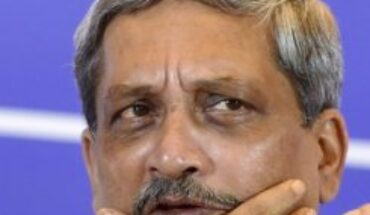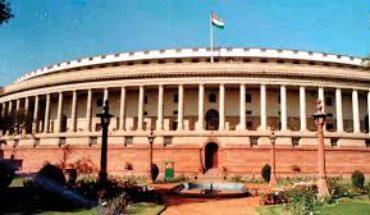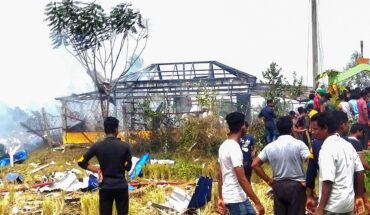Chhavi Bhatia
Chandigarh—It was not a usual morning for Amb Sahib Gurudwara on June 26. Since 5 am, cars, minivans and tractors carrying hundreds of farmers had started arriving outside, piercing its quiet with roaring engines. Kisan flags in shades of green, white and red fluttered high, adding to the white beauty of the magnificent building in the backdrop. After offering morning prayers inside, the farmers waited patiently for their leaders to arrive and more to join them. 20 km away at Nada Sahib Gurudwara, Panchkula, a similar scene was playing out.
June 26 marked the completion of seven months of the farmers’ protest on the Delhi borders where hundreds of thousands of farmers have been holding a peaceful sit-in since November 26. To mark the occasion, the Samyukta Kisan Morcha(SKM—umbrella body of the farmers’ union—had given a call to gherao Raj Bhawans in Chandigarh and submit memorandum of their demands to Governors of Punjab and Haryana.
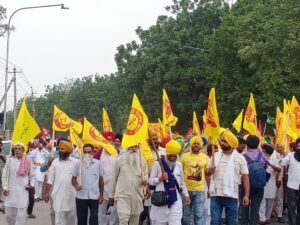
By nine, senior Bharatiya Kisan Union leaders—Balbir Singh Rajewal, Ruldu Singh Mansa, Manjit Singh Rai, Harmeet Singh Qadian were addressing a continuous swell of farmers from a makeshift stage outside Amb Sahib Gurudwara. “We have set an example for the world what a peaceful agitation looks like. Seven months is not a small time. This is our collective achievement and we should be proud of ourselves for coming this far,” roared Qadian amidst loud jaikaras. “These months have taught us that our opponent—the government—is obstinate and unwilling to fulfill our demands. We want to tell the BJP once again that we come from the lineage of Guru Gobind Singh and Hari Singh Nalwa. We fight to win,” he thundered. Mansa and Rajewal also congratulated the congregation, reiterating that the goal is to get the three controversial farm laws repealed.
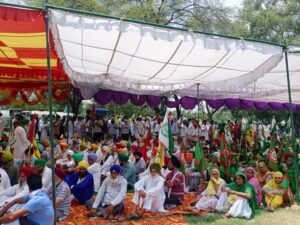
An hour later, the leaders led a procession from the gurughar towards Punjab Raj Bhawan, Sector 6. Flanked by thousands of farmers, a lot of whom had come from far-off villages in Punjab, they marched towards City Beautiful in blistering heat. In the meanwhile, to make it less grueling for the farmers in the peak of summers, locals had set up chhabeels outside the gurudwara and by the roadside. Women and young children smilingly offered the sweet concoction of roohafza, milk and water as the contingent walked past raising slogans against the government. “This support has helped us carry on with our struggle. We know that people beyond the farming community also believe in our cause. They are an indispensable part of the movement,” said Sukhpal Dhillon, a farmer from Muktsar Sahib. “I brought my daughter to do sewa and also to witness history. I have never seen so many protesters all at once in Tricity. Their jazba is awe-inspiring but more than that is the selfless attitude with which they are fighting for all of us,” said Kuldeep Kaur, a resident of Phase VI, Mohali.
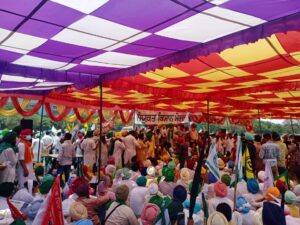
On the other hand, Chandigarh Police had turned the city into a fortress, specially Sukhna Path and arterial roads leading to Sector 6. Apart from heavy patrolling and barricading, the UT Police had blocked the Govt Press Chowk with buses and water cannons. Even as the farmers marched on peacefully despite being thousands in number, they were met with water cannons to thwart any attempts to enter the twin capital.
Outnumbering the cops, thousands of farmers managed to enter Chandigarh by afternoon, breaking barricades and braving water cannons. While they were not allowed to reach the Raj Bhawan, farmer leader Rajewal handed over the memorandum to Chandigarh deputy commissioner Mandeep Singh Brar.


